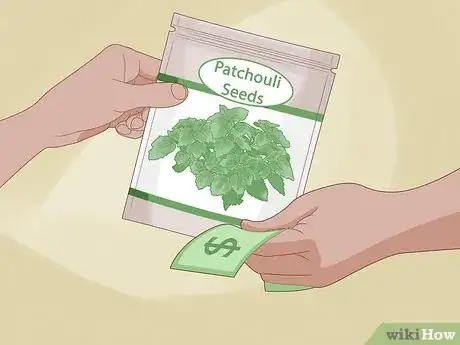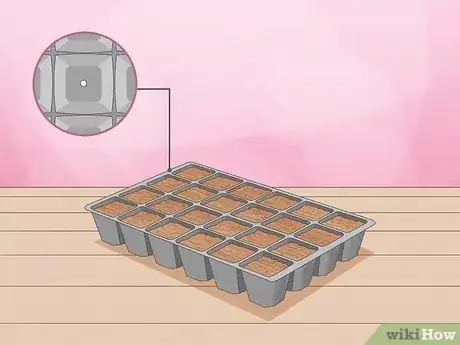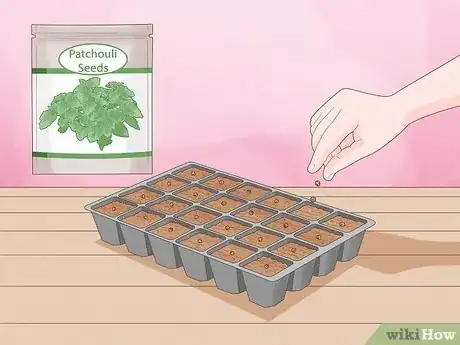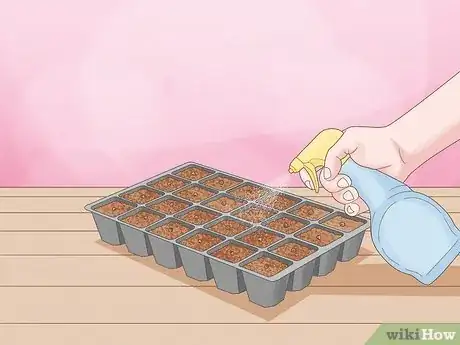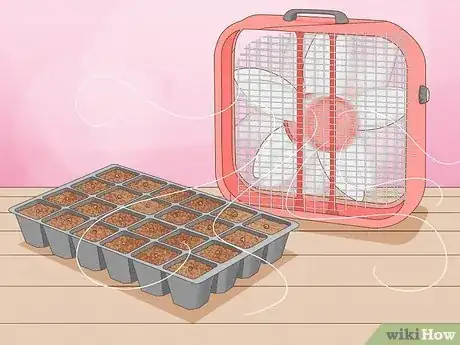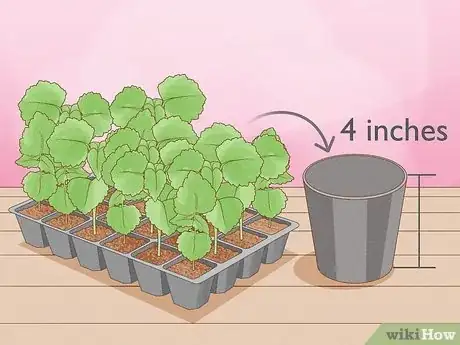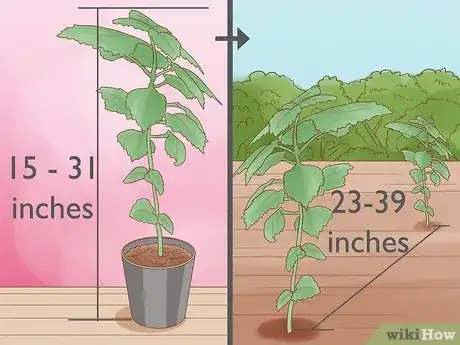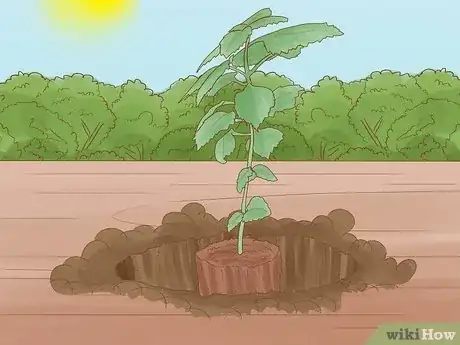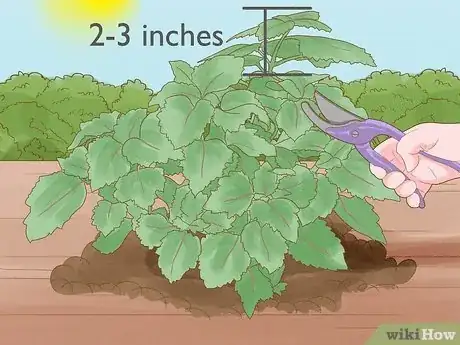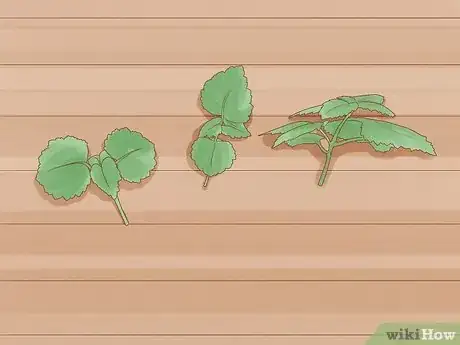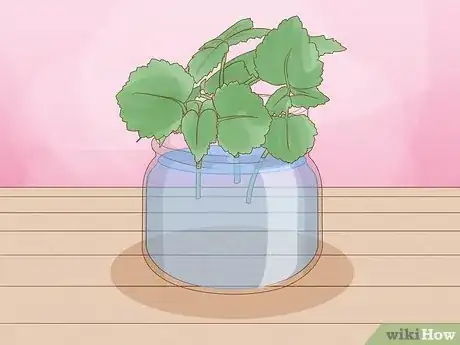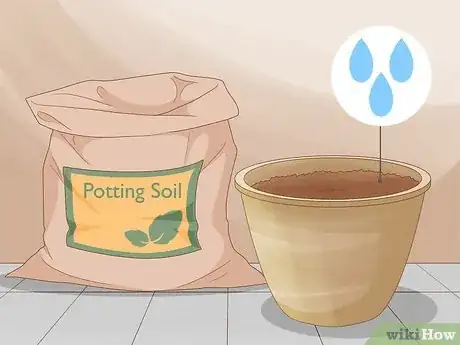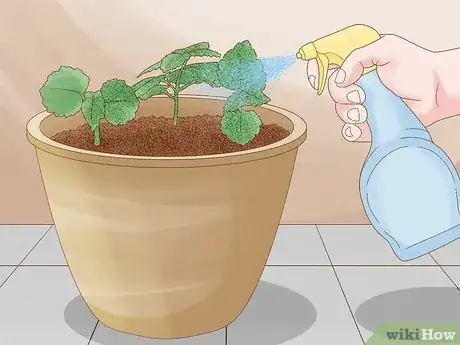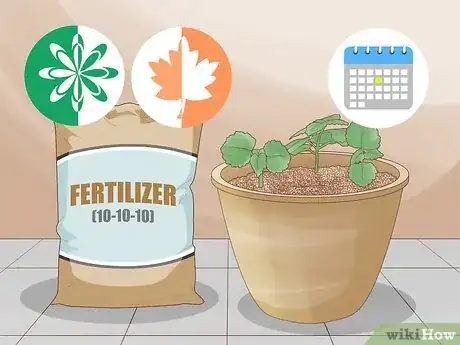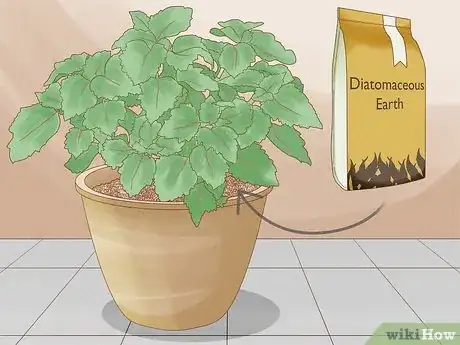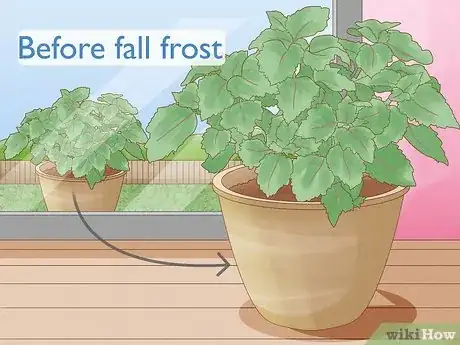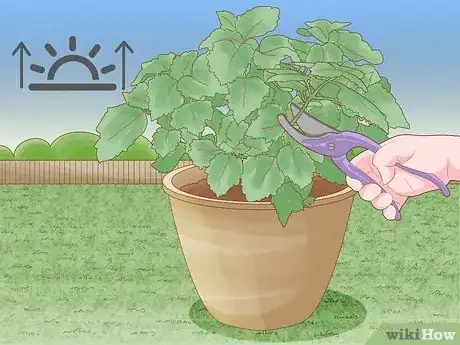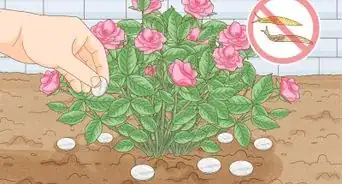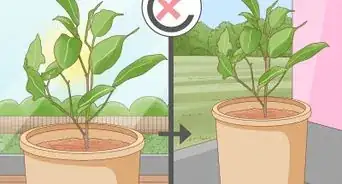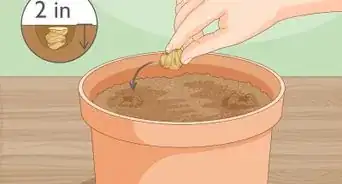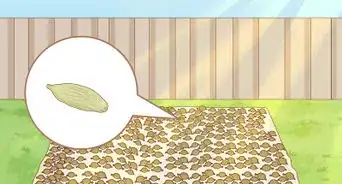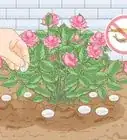This article was co-authored by Lauren Kurtz. Lauren Kurtz is a Naturalist and Horticultural Specialist. Lauren has worked for Aurora, Colorado managing the Water-Wise Garden at Aurora Municipal Center for the Water Conservation Department. She earned a BA in Environmental and Sustainability Studies from Western Michigan University in 2014.
There are 12 references cited in this article, which can be found at the bottom of the page.
wikiHow marks an article as reader-approved once it receives enough positive feedback. In this case, several readers have written to tell us that this article was helpful to them, earning it our reader-approved status.
This article has been viewed 75,621 times.
Patchouli is famous for its spicy, earthy, complex aroma. It has jagged, green leaves with small white flowers. A relative of the mint family, patchouli became popular as a fragrance during the 1960s and is often associated with hippie culture. Native to Asia, it is happiest growing in warm to tropical climates, including parts of Southern California, Arizona, and Florida. With proper care, it can be grown in cooler climates.[1]
Steps
Germinating Patchouli
-
1Purchase patchouli seeds. Visit your local nursery to discuss the options for ordering it in, or purchase seeds online from a reputable garden retailer.[2]
- If you don’t own planting flats, you should purchase them at the same time as the seeds.
-
2Prepare the soil and lighting conditions for your planting flat. Use a planting flat or tray with holes in the bottom, and fill it with warm, humousy soil. You can use regular potting soil. Leave the soil rough on the top. You should have it in a sunny part of your house, such as in front of a window, or under grow lights.[3]
- You could also prepare your own potting soil with a mix of equal parts vermiculite, peat moss and perlite.[4]
- It is best to start seeds in wide, shallow containers. Wide containers such as seeding flats or trays prevent overcrowding.[5]
- You can also use recycled plastic containers, such as yogurt containers. Punch holes in the bottom to help the soil drain.
Advertisement -
3Sprinkle the patchouli seeds over the surface of the flat. The seeds should fall down between the cracks of the rough surface of the soil. Then, pat down the humous-rich soil with the palm of your hand. After tamping, the seeds should be barely covered by the warm, humousy soil.[6]
- Each seed needs to be in direct contact with the moist soil in order to germinate.[7]
- You can also use the bottom of a glass or a pestle to tamp the seeds into the soil.
-
4Spray the flat with a fine mist of water. Use a fine mist setting on your garden sprayer, so that you don’t dislodge the seeds with the force of the sprayer. Keep the planting flat in a nice warm location until germination, which should take between one and three weeks. During this time, keep the soil nice and moist.[8]
- If you are concerned about fungal infection or “damping-off,” you can sprinkle a mixture of fifty percent milled sphagnum and fifty percent starter chicken grit. Spread it thinly over the surface of the flats, which will help prevent pathogens.
- To retain moisture, you can put a plastic wrap over the seed tray. This will help to create a humid environment.[9]
- Avoid overwatering the seeds, which will disturb the seeds and prevent proper germination.
- If you put your finger an inch into the soil and it feels dry, you should water. If it is still damp, you don’t need to water.
-
5Blow air over the surface of the trays with a fan. Place a fan in front of the tray. Put the fan on a low setting. Blow air over the top of the trays to promote good air circulation, which will help to prevent disease.[10]
-
6Separate the seedlings into four-inch pots. Once the seedlings grow a second set of leaves, you can separate them out of the planting tray. Gently pull up the plant from the soil, lifting the plant up from below the roots. Transplant the seedling into a four-inch pot. Let them grow until they fill the pot with roots. At this point, they are ready to put in the ground outside or in a larger pot.[11]
- To see whether the pot is full of roots, look underneath the four-inch pot. You should be able to see the roots through the water holes at the bottom of the pot.
- If you don’t have time to germinate the patchouli yourself, you can buy a seedling from the garden center or online.
Planting Patchouli Seedlings
-
1Find a sunny place for your patchouli plants. The patchouli plant likes moist but well-draining soil. It likes full sun to partial shade, so find a nice place in your backyard or near a sunny window. Make sure your plant gets at least 4-6 hours of sunlight each day.[12]
- Patchouli will grow as a container plant indoors. Just don't place it too close to the window where it can easily burn.
- Patchouli doesn’t like temperatures that go below 15 Celsius (59 Fahrenheit).[13]
-
2Give the patchouli plants some room to grow. Your patchouli plants should grow up to somewhere between 15 and 31 inches in height (40–80 centimeters). You will need to plant them between 23 (60 centimeters) and 39 inches (100 centimeters) apart.[14]
-
3Place the seedlings in composted planting holes. Dig a hole for each seedling. Put some compost at the bottom of each hole. Make sure that the soil is warm before planting the seedlings. Transfer the seedling from the pot where you germinated it. Tamp the soil down around the plant. Then, mulch the plant to help keep moisture in.[15]
Using Cuttings
-
1Cut short branches from the crown of the plant. Use a sharp knife or snips to get a clean cutting. Cut short, two or three inch branches from near the crown of the patchouli plant. Harvest only these young, green shoots and avoid cutting off the woody older branches. Remove the leaves from the bottom of each cutting.
- Choose branches that have at least one node, which is where you have a stem with little buds where flowers or leaves are growing.[16]
- If you have a friend with a pot of patchouli, you can use cuttings from their plant to grow patchouli.
- It is best to gather cuttings in the late summer or early fall.
-
2Get multiple cuttings to ensure you get one that takes root. To make sure you get at least one cutting that takes root, you should cut three or four branches from each of your patchouli plants. This will give you some insurance in case some of them fail to grow.
-
3Put the cuttings into room temperature water in clean mason jars. You should use sterilized glass jars, such as mason jars. Fill the jar with water up to the lowest set of leaves on the cutting. The water should be room temperature. When the roots of the cutting grow to between one quarter and half an inch in length, you can plant them in a pot.
- Every three days, replace the water in the jar.
- For even more growth, dip the roots in a rooting hormone before placing them in the water.
-
4Fill a large pot with moist potting soil. Use a small stick to make little planting holes in the pot. Space the holes a few inches apart, wherever you want to propagate a patchouli plant.[17]
-
5Put the cuttings in the pot with the roots in the soil. Each cutting should have one node that is above the soil. Water the cuttings. Put a cover over the pot to retain humidity. Eventually, at least a couple of the patchouli plants should take root. You will have a new patchouli plant by springtime![18]
- If you live in a cooler climate where freezing occurs, you should bring the pots inside during the winter.
Caring for Patchouli Plants
-
1Water your patchouli on a daily basis with the mister setting. The patchouli plant needs to remain moist, especially as the temperatures rise in the summer months. It may need daily watering during the summer and in hotter climates. You can use the mister on your garden hose or a sprinkler to increase humidity.[19]
- To determine whether the plants need water, put your finger an inch into the soil. If it feels a bit dry at the bottom of your finger, you should water the plants.
-
2Keep your patchouli plants well fertilized. Use liquid fish fertilizer or rotted manure.[20] You can use a 10-10-10 fertilizer. Apply the fertilizer in the spring and then once per month until the fall.[21]
-
3Use diatomaceous earth to ward off insects. A chalk-like powder that is entirely harmless to humans but kills insects by dehydrating them, diatomaceous earth is a wonderful solution for organic pest control. Sprinkle it on top of the soil surrounding your patchouli plant. Any insects that try to eat the patchouli will be kept away or die.
-
4Bring patchouli plants inside before the fall frost. Since patchouli plants are extremely sensitive to cold temperatures, you’ll want to bring the plants inside before the cold weather hits in the fall. Look at upcoming weather and bring your plants inside well ahead of the first frost date in your region.[22]
- In the spring, you should avoid putting your pots of patchouli outside prior to the last frost date for your region.
-
5Harvest patchouli leaves. The leaves can be harvested as soon as they develop their distinctive green color. They can be harvested continuously throughout the growing season, as long as you are just pruning a part of the plant or taking a few leaves. If you want to harvest more of the plant, you should probably wait until the fall.[23] Dry them and add them to potpourri sachets for a rich, earthy fragrance.[24]
- It is best to harvest in the morning or at least before noon.[25]
- It is best to only harvest about a third of the plant at a time, unless you are planning to pull the whole plant up at the end of the season.
Community Q&A
-
QuestionWhere are the patchouli seeds found on the plant?
 NinoxTop AnswererYou can find seed on the plant after the flowers have withered. If you want to grow more plants, the best thing to do is use cuttings.
NinoxTop AnswererYou can find seed on the plant after the flowers have withered. If you want to grow more plants, the best thing to do is use cuttings. -
QuestionHow much sunlight does a patchouli plant need?
 NinoxTop AnswererPatchouli plants need a lot of light. You must place it in bright sun, but when you bring out the plant for the first time in the spring, don't expose it to the sun too quickly.
NinoxTop AnswererPatchouli plants need a lot of light. You must place it in bright sun, but when you bring out the plant for the first time in the spring, don't expose it to the sun too quickly. -
QuestionCan I grow patchouli in New York?
 Community AnswerYes, you can, but you'll need to bring in the plant when the temperature drops below 50°F (10°C).
Community AnswerYes, you can, but you'll need to bring in the plant when the temperature drops below 50°F (10°C).
Things You'll Need
- Patchouli seeds or cuttings
- Pruning shears
- Four-inch pots
- Seeding tray
- Watering hose with a mister
- Potting soil
- Sterilized mason jars
References
- ↑ http://www.motherearthliving.com/gardening/plant-profile/patchouli-herb-zmaz91djzgoe
- ↑ https://strictlymedicinalseeds.com/product/patchouli-true-pogostemon-cablin-packet-of-10-seeds-organic/
- ↑ https://strictlymedicinalseeds.com/product/patchouli-true-pogostemon-cablin-packet-of-10-seeds-organic/
- ↑ http://www.motherearthliving.com/gardening/plant-profile/patchouli-herb-zmaz91djzgoe?pageid=2#PageContent2
- ↑ http://www.finegardening.com/10-seed-starting-tips
- ↑ https://strictlymedicinalseeds.com/product/patchouli-true-pogostemon-cablin-packet-of-10-seeds-organic/
- ↑ http://www.finegardening.com/10-seed-starting-tips
- ↑ https://strictlymedicinalseeds.com/product/patchouli-true-pogostemon-cablin-packet-of-10-seeds-organic/
- ↑ http://www.finegardening.com/10-seed-starting-tips
- ↑ http://www.gardenersnet.com/atoz/germinat.htm
- ↑ https://strictlymedicinalseeds.com/product/patchouli-true-pogostemon-cablin-packet-of-10-seeds-organic/
- ↑ http://www.thegrowers-exchange.com/Patchouli_p/her-pat01.htm
- ↑ https://www.richters.com/show.cgi?page=QandA/Growing/19980331-80.html
- ↑ https://www.richters.com/show.cgi?page=QandA/Growing/19980331-80.html
- ↑ http://yougrowgirl.com/my-freaking-awesome-plant-patchouli/
- ↑ https://littlehouseinthesuburbs.com/2012/11/propagating-from-cuttings.html
- ↑ https://littlehouseinthesuburbs.com/2012/11/propagating-from-cuttings.html
- ↑ https://littlehouseinthesuburbs.com/2012/11/propagating-from-cuttings.html
- ↑ https://www.richters.com/show.cgi?page=QandA/Growing/19980331-80.html
- ↑ https://www.richters.com/show.cgi?page=QandA/Growing/19980331-80.html
- ↑ https://www.gardeningknowhow.com/edible/herbs/patchouli/growing-patchouli-herb-plant.htm
- ↑ http://www.thegrowers-exchange.com/Patchouli_p/her-pat01.htm
- ↑ https://davesgarden.com/guides/pf/go/53931/
- ↑ http://www.motherearthliving.com/gardening/plant-profile/patchouli-herb-zmaz91djzgoe
- ↑ http://www.herbs2000.com/h_menu/1_garden_harvest.htm
About This Article
To grow patchouli from a seedling, find a spot outdoors that gets at least 4-6 hours of sunlight a day, where water does not pool after a heavy rain. You can also plant the patchouli in a container if you want to grow it indoors, but do not place it too close to a window. Dig a hole for each seedling, spacing them about 23-39 inches apart, and put some organic compost at the bottom of each hole. Place each seedling in a hole and tamp down the soil around the plant, then add a layer of mulch to help keep moisture in. For tips on germinating patchouli seeds, keep reading!
